Cite this document
(Child Language Disorder Research Paper Example | Topics and Well Written Essays - 2500 words, n.d.)
Child Language Disorder Research Paper Example | Topics and Well Written Essays - 2500 words. https://studentshare.org/health-sciences-medicine/1845363-child-language-disorder
Child Language Disorder Research Paper Example | Topics and Well Written Essays - 2500 words. https://studentshare.org/health-sciences-medicine/1845363-child-language-disorder
(Child Language Disorder Research Paper Example | Topics and Well Written Essays - 2500 Words)
Child Language Disorder Research Paper Example | Topics and Well Written Essays - 2500 Words. https://studentshare.org/health-sciences-medicine/1845363-child-language-disorder.
Child Language Disorder Research Paper Example | Topics and Well Written Essays - 2500 Words. https://studentshare.org/health-sciences-medicine/1845363-child-language-disorder.
“Child Language Disorder Research Paper Example | Topics and Well Written Essays - 2500 Words”. https://studentshare.org/health-sciences-medicine/1845363-child-language-disorder.


